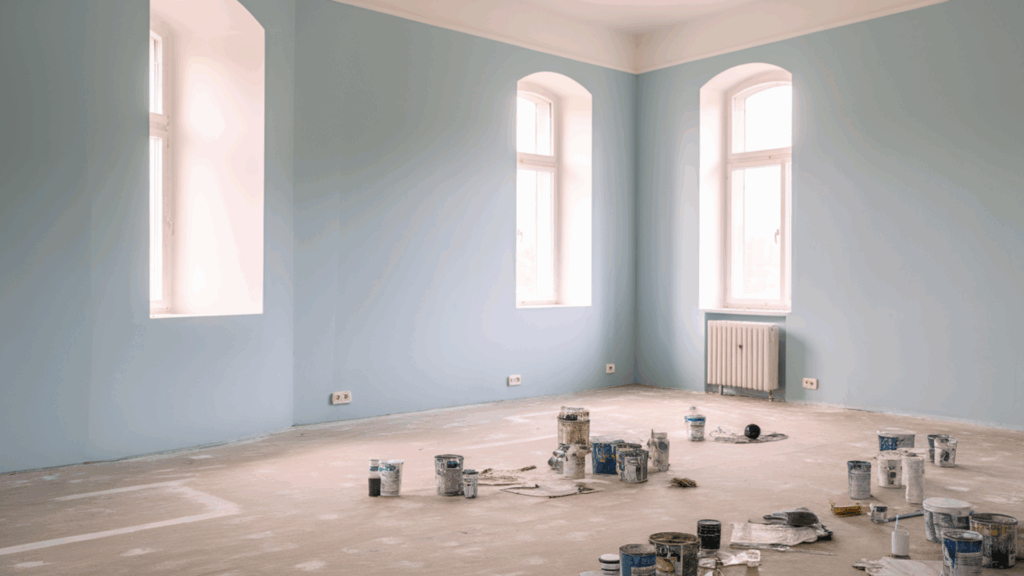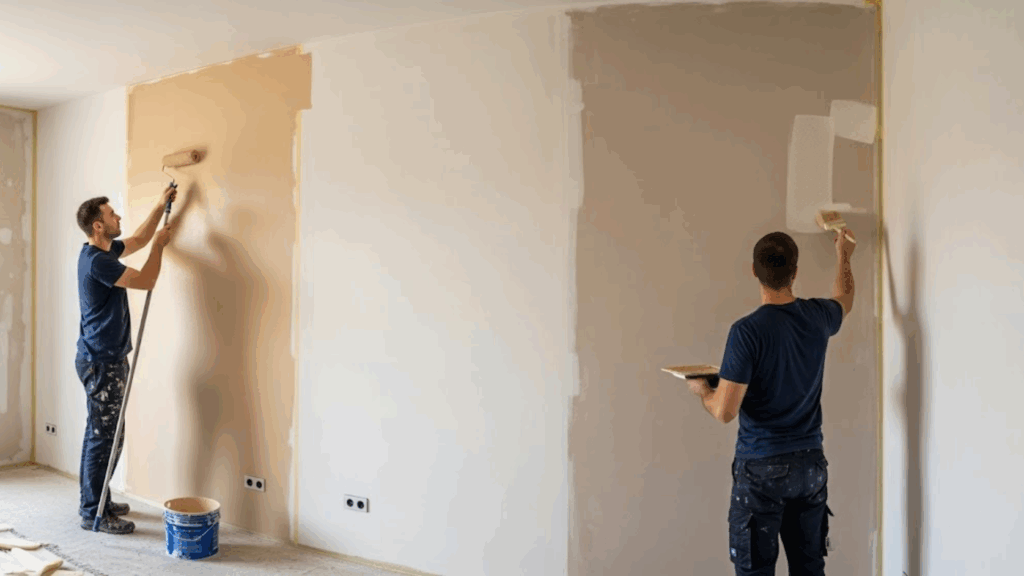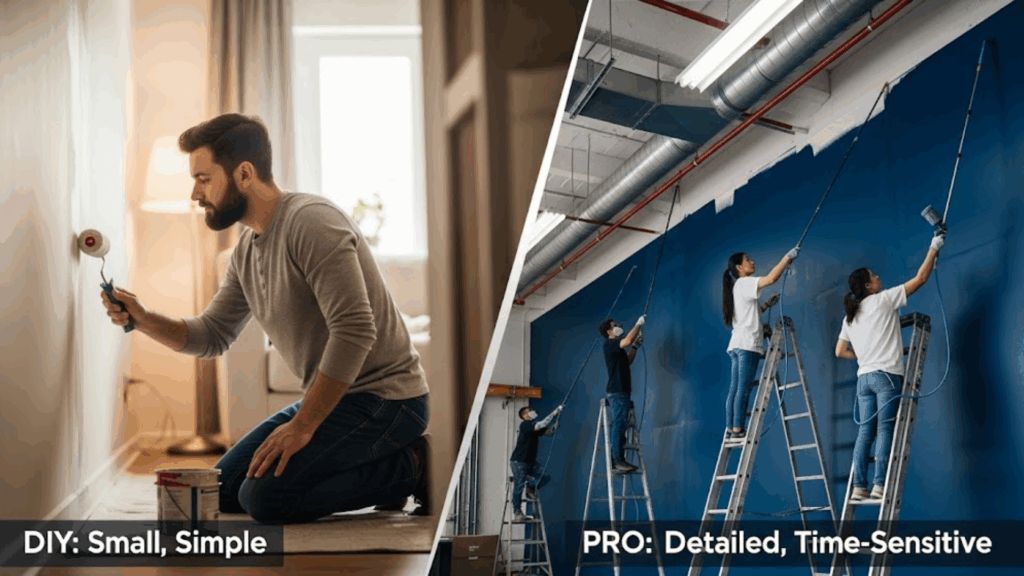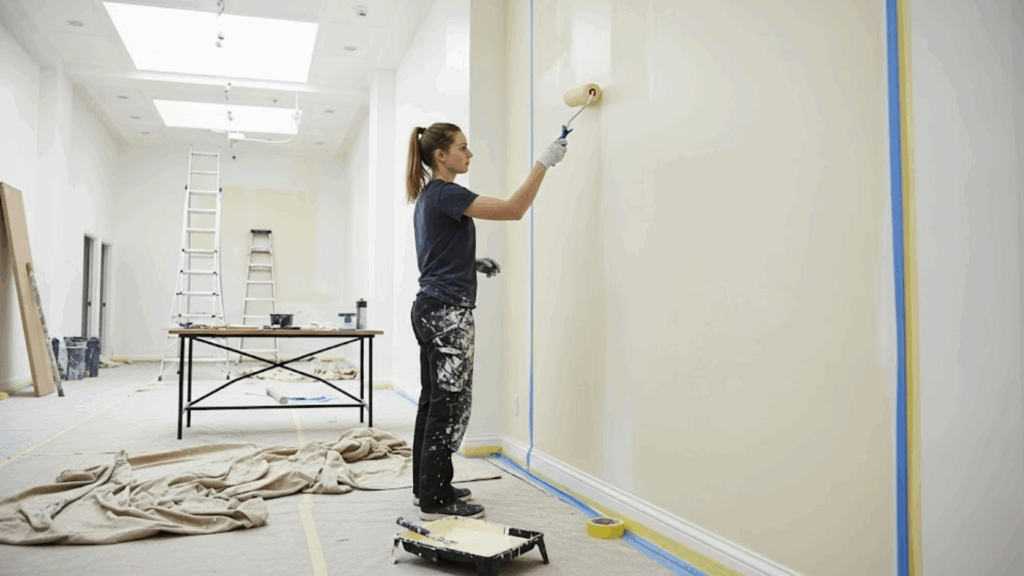When I opened my first retail space, I didn’t think much about the walls. But once the furniture was in and the signs were up, I realized the beige walls just didn’t match the style or atmosphere I wanted.
A solid paint job completely changed the space, making it feel clean, refreshed, and business-ready. If you’re considering painting your commercial space, I’ve been through the same process.
It’s one of those upgrades that seems easy until you start gathering estimates.
One of the first things I wanted to figure out was: how much is this going to cost per square foot? And I know that’s a common question.
In this blog, I’ll explain what to expect when it comes to commercial interior painting costs in the U.S., including pricing ranges and what factors influence the total.
I’ll also share a few ways I managed to cut costs without compromising on quality.
What’s the Average Cost Per Square Foot?
Most commercial interior painting projects cost between $1 and $4 per square foot.
- Basic option (minimal prep, one coat): $1–$1.50 per sq ft
- Standard option (two coats, moderate prep): $2–$3 per sq ft
- Higher-end option (extensive prep, tall walls, complex surfaces): $3–$4+ per sq ft
So, if your space is around 3,000 sq ft, you’re likely looking at a cost between $3,000 and $12,000, depending on the level of preparation and finishing you’re aiming for.
What Impacts the Price of Commercial Interior Painting?

Square footage, ceiling height, prep needs, paint quality, finish type, and local labor rates all affect commercial painting costs, sometimes more than you’d expect.
- Square Footage: The larger the space, the more paint and time it takes. That’s simple. But I also found that rooms with unusual shapes or a lot of corners take more time to paint, even if they’re small.
- Ceiling Height: When I got an estimate for a space with 12-foot ceilings, I was surprised by the added cost. Painters require ladders, scaffolding, and additional time to cover tall walls, resulting in a rapid increase in labor costs.
- Prep Work: In one of my stores, I had to deal with peeling paint and a few drywall cracks. Fixing those bumps up the price. If your walls are in good shape already, you’ll spend less.
- Paint Type and Finish: Choosing the cheapest paint might seem like a smart move, but I’ve found that quality paint holds up better, especially in areas with high foot traffic.
- Location-Based Labor Rates: Where you are in the U.S. matters. In New York or California, labor is more expensive than in smaller towns. I’ve paid anywhere from $30 to $60 per hour, depending on the painter and the region.
Commercial Interior Painting: Sample Cost Breakdown
| Space Type | Approx Size | Estimated Cost Range |
|---|---|---|
| Retail Store | 2,000 sq ft | $2,000–$6,000 |
| Office Suite | 3,500 sq ft | $4,000–$10,500 |
| Restaurant Interior | 1,800 sq ft | $2,500–$7,000 |
| Medical Clinic | 2,500 sq ft | $3,000–$8,500 |
| Warehouse Office | 4,000 sq ft | $5,000–$13,000+ |
What’s Usually Included in the Cost?

From the quotes I’ve received, here’s what’s typically included:
- Surface cleaning (dust and grime removal)
- Light patching and sanding
- Priming (if needed)
- Two coats of paint
- Basic trim or baseboard painting
- Cleanup
Always request a detailed breakdown to avoid any surprises. I once found out trim wasn’t included, after the job was done.
Tips for Keeping Commercial Interior Painting Costs Down
Combine locations, be flexible with timing, do basic prep yourself, and limit color changes. These simple steps helped me save without compromising the quality of my paint jobs.
1. Ask for Multi-Site Discounts
If you’re painting several locations, consider grouping the work under one contractor. I did this and saved 15% by negotiating a combined deal.
It’s a practical way to lower overall costs while maintaining consistent results. Always ask if a discount is available for handling multiple sites together.
2. Be Flexible with Scheduling
I’ve secured better rates by allowing painters to work during off-hours or slower times of the year, such as winter. Being flexible with scheduling can lower your overall cost.
Contractors often appreciate having steady work in quieter months, and that can translate into real savings for your business.
3. Handle Some Prep Work Yourself
When I have the time, I handle simple prep tasks myself, such as moving furniture, wiping down walls, or removing outlet covers.
These small efforts make the job easier for the painters and help reduce labor charges. Taking care of the basics can lead to noticeable savings on your final bill.
4. Limit Color Changes
Once, I chose four different paint colors, and it turned out to be a bad call. It slowed down the project, increased paint usage, and raised the overall cost.
In most cases, one or two colors are enough to create a clean, professional look without adding unnecessary complications or expenses.
How Often Should Commercial Interiors Be Repainted?
Most commercial interiors typically need repainting every 5–7 years. High-traffic areas, like waiting rooms, changing rooms, or staff areas, may require more frequent updates.
To maintain a fresh look, small touch-ups can be done every 2–3 years, preventing the need for a full repaint.
Regular maintenance ensures that the space remains appealing and well-kept without the expense and disruption of a complete repaint.
Should You DIY or Hire a Pro for Commercial Interior Painting?

DIY works for small, simple spaces with time to spare. For larger, detailed, or time-sensitive jobs, hiring professionals gives better results and saves hassle.
Choose DIY If
- The space is under 1,000 sq ft
- You’re watching your budget and have a few days free
- The layout is simple (no high walls, no tricky spots)
Go with a Pro If
- You’re short on time
- You want a polished look, or need multiple rooms done
- There’s patchwork, tall walls, or anything detailed involved
In my experience, hiring pros is worth it for bigger spaces or customer-facing areas. You don’t want uneven lines or messy edges to detract from your store’s appearance.
Conclusion
I’ve painted a few commercial spaces over the years, and every time I do, I’m reminded how much of a difference it makes. Fresh paint makes a store feel cleaner, more welcoming, and frankly, more put together.
Knowing that most commercial interior painting jobs fall between $1 and $4 per square foot has helped me budget better and avoid last-minute costs.
If you’re considering painting your space, take accurate measurements, obtain a few quotes, and ask detailed questions.
My suggestion? Select high-quality paint, maintain a simple color palette, and hire painters with strong online reviews.
A well-executed paint job can significantly enhance the perception of your business to both customers and staff.
It might seem small, but your walls are one of the first things people notice. Ensure they reflect the kind of space you want to operate in.

